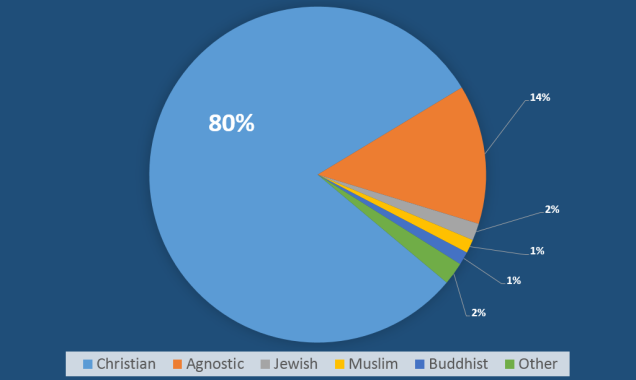There is no shortage of religious denominations in America. According to most estimates, there are upwards of 200 reasonably sized Christian denominations alone in America.
The Association of Religion Data Archives (ARDA) website contains an impressive amount of information about the religious makeup of the United States. Despite the increasing influence of secularism in America, Christians still make up about 70-80% of the American population, with the exact number depending on how “Christian” is defined. Here’s a chart of how other religions stack up:

American Christianity can typically be divided into smaller groups based on common beliefs. Most broadly, Christians can be thought of as being either Catholic or Protestant. Based on fairly recent estimates, there are about twice as many Protestant Christians in America than there are Catholics. Using information from ARDA, I created a map of the United States that shows if there are more Catholic or Protestant Christians in each state:

As you can see, the vast majority of states (42 of them) have more Protestant Christians than Catholics. Only 8 states, all situated on the upper East Coast, have more Catholics than Protestants.
The Protestant Christian category can be further subdivided into Mainline Protestants and Evangelical Protestants. The Mainline Protestant category would include, for example, certain Reformed churches like the United Methodist Church, the Presbyterian Church (U.S.A.), and the Episcopal Church. This category also includes the Evangelical Lutheran Church in America. Many of these churches are more theologically liberal than their Evangelical Protestant counterparts.
The other category, Evangelical Protestant, is typically composed of various Baptist, Pentecostal, Anglican, and some Reformed churches. This category would also include the Lutheran Church – Missouri Synod (LCMS) and the Wisconsin Evangelical Lutheran Synod. Most churches in the Evangelical category are known for being theologically and socially conservative.
Broken down into percentage, about 60% of Protestants belong to Evangelical churches, while the other 40% belong to Mainline churches.
There are a few other religious groups that have a strong showing in America, such as the Church of Jesus Christ of Latter-day Saints (Mormons), Judaism, and Islam. Using information from ARDA, I created another two maps that show the largest and second largest denominations in each state:


Only two non-Christian religious groups show up on these maps –
- The Church of Jesus Christ of Latter-day Saints, also known as Mormons (although they are widely considered by many to be just another Christian group, their vast theological differences from historical Christianity are enough, in my mind, to consider them far outside of the Christian Church.) Looking between both of the above maps, it’s obvious that the Mormon Church has a great foothold in the Westernmost states, and, interestingly, Hawaii.
- Orthodox Judaism, which is the second largest religious denomination in New York
You might note that even in many states that have more Protestants than Catholics, the Catholic Church is still the largest single denomination. This is because Protestantism is so divided into different denominations and the number is split between them.
On the first map, it can be easily seen that the Southern Baptist Convention is the most prominent religious group in states around the “Bible Belt,” a region that is well-known for Evangelical Protestants with social conservatism.
On the second map, it’s also apparent that Lutheranism has a good showing within the Northeastern Midwest in the states of Wisconsin, Minnesota, North Dakota, South Dakota, and Nebraska. The Evangelical Lutheran Church in America is very prominent in these states, and the Lutheran Church – Missouri Synod is the second largest denomination in Nebraska, only behind the Catholic Church.
The United Methodist Church has an impressive number of adherents in the middle of the Eastern portion of America, and is actually the denomination with the most adherents in West Virginia.
In Maryland, Alaska, and New Jersey, non-denominational Christians were the second largest “group.” I put them on the map because I thought it was very interesting that there were that many Christians without a denomination. If non-denominational Christians aren’t considered for this map (due to the fact that they are, as per their name, not a denomination), then the second largest group in Alaska is the Mormon Church, the second largest in Maryland is the United Methodist Church, and the second largest in New Jersey is Islam.
Here’s an interesting factoid: During the process of gathering information for these maps, I visited all 50 states’ Wikipedia pages to look for summaries of their religious demographics. Out of all of the 50 states, Vermont’s page was the only one that did not contain a section on religious demographics. In fact, the words “religion” and “Christian” do not even appear at all on Vermont’s Wikipedia page.
Although many of the more mainstream groups within American Christianity have abandoned some of the most basic Christian Biblical principles, we still ought to be thankful that the vast majority of Americans at least identify themselves as Christians. It is our mission as followers of Christ to live out our vocations and contribute to the things that make this nation great.